Yamaha R-S700BL, R-S500BL User Manual

U
Receiver
OWNER’S MANUAL
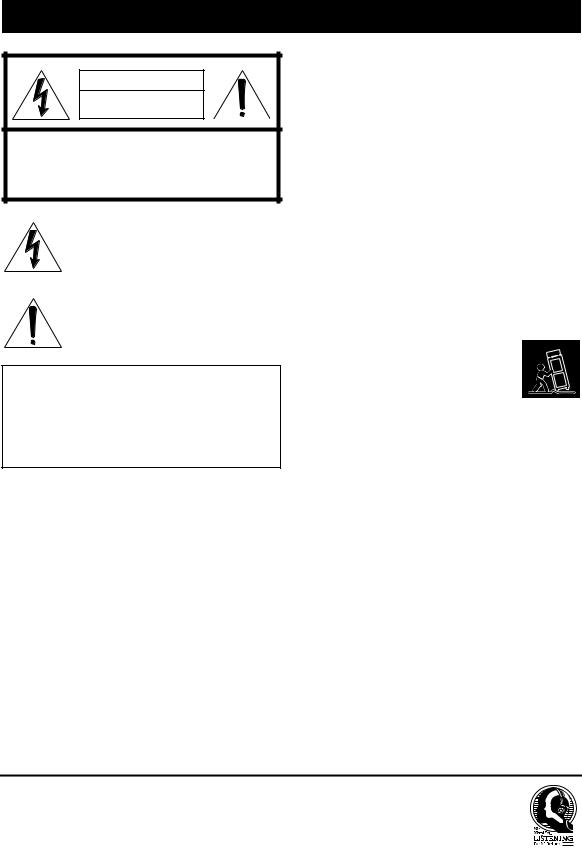
IMPORTANT SAFETY INSTRUCTIONS
CAUTION |
RISK OF ELECTRIC SHOCK |
DO NOT OPEN |
CAUTION: TO REDUCE THE RISK OF |
ELECTRIC SHOCK, DO NOT REMOVE |
COVER (OR BACK). NO USER-SERVICEABLE |
PARTS INSIDE. REFER SERVICING TO |
QUALIFIED SERVICE PERSONNEL. |
• Explanation of Graphical Symbols
The lightning flash with arrowhead symbol, within an equilateral triangle, is intended to alert you to the presence of uninsulated “dangerous voltage” within the product’s enclosure that may be of sufficient magnitude to constitute a risk of electric shock to persons.
The exclamation point within an equilateral triangle is intended to alert you to the presence of important operating and maintenance (servicing) instructions in the literature accompanying the appliance.
IMPORTANT
Please record the serial number of this unit in the space below.
MODEL:
Serial No.:
The serial number is located on the rear of the unit. Retain this Owner’s Manual in a safe place for future reference.
1Read these instructions.
2Keep these instructions.
3Heed all warnings.
4Follow all instructions.
5Do not use this apparatus near water.
6Clean only with dry cloth.
7Do not block any ventilation openings. Install in accordance with the manufacturer’s instructions.
8Do not install near any heat sources such as radiators, heat registers, stoves, or other apparatus (including amplifiers) that produce heat.
9Do not defeat the safety purpose of the polarized or grounding-type plug. A polarized plug has two blades with one wider than the other. A grounding type plug has two blades and a third grounding prong. The wide blade or the third prong are provided for your safety. If the provided plug does not fit into your outlet, consult an electrician for replacement of the obsolete outlet.
10Protect the power cord from being walked on or pinched particularly at plugs, convenience receptacles, and the point where they exit from the apparatus.
11Only use attachments/accessories specified by the manufacturer.
12Use only with the cart, stand, tripod,
bracket, or table specified by the manufacturer, or sold with the apparatus. When a cart is used, use caution when moving the cart/apparatus combination to avoid injury from tip-over.
13Unplug this apparatus during lightning storms or when unused for long periods of time.
14Refer all servicing to qualified service personnel. Servicing is required when the apparatus has been damaged in any way, such as power-supply cord or plug is damaged, liquid has been spilled or objects have fallen into the apparatus, the apparatus has been exposed to rain or moisture, does not operate normally, or has been dropped.
We Want You Listening For A Lifetime
Yamaha and the Electronic Industries Association’s Consumer Electronics Group want you to get the most out of your equipment by playing it at a safe level. One that lets the sound come through loud and clear without annoying blaring or distortion – and, most importantly, without affecting your sensitive hearing. Since hearing damage from loud sounds is often undetectable until it is too late, Yamaha and the Electronic Industries Association’s Consumer Electronics Group recommend you to avoid prolonged exposure from excessive volume levels.
i En

|
|
IMPORTANT SAFETY INSTRUCTIONS |
|
|
|
|
|
|
FCC INFORMATION (for US customers) |
||
|
|
|
|
|
1 IMPORTANT NOTICE: DO NOT MODIFY THIS |
Compliance with FCC regulations does not guarantee |
|
|
UNIT! |
that interference will not occur in all installations. If |
|
|
This product, when installed as indicated in the |
this product is found to be the source of interference, |
|
|
instructions contained in this manual, meets FCC |
which can be determined by turning the unit “OFF” |
|
|
requirements. Modifications not expressly approved by |
and “ON”, please try to eliminate the problem by using |
|
|
Yamaha may void your authority, granted by the FCC, |
one of the following measures: |
|
|
to use the product. |
Relocate either this product or the device that is being |
|
|
2 IMPORTANT: When connecting this product to |
||
|
affected by the interference. |
||
|
accessories and/or another product use only high quality |
||
|
Utilize power outlets that are on different branch |
||
|
shielded cables. Cable/s supplied with this product MUST |
||
|
be used. Follow all installation instructions. Failure to |
(circuit breaker or fuse) circuits or install AC line |
|
|
follow instructions could void your FCC authorization to |
filter/s. |
|
|
use this product in the USA. |
In the case of radio or TV interference, relocate/ |
|
|
3 NOTE: This product has been tested and found to comply |
reorient the antenna. If the antenna lead-in is 300 ohm |
|
|
ribbon lead, change the lead-in to coaxial type cable. |
||
|
with the requirements listed in FCC Regulations, Part 15 |
||
|
|
|
|
|
for Class “B” digital devices. Compliance with these |
If these corrective measures do not produce |
|
|
requirements provides a reasonable level of assurance that |
satisfactory results, please contact the local retailer |
|
|
your use of this product in a residential environment will |
authorized to distribute this type of product. If you can |
|
|
not result in harmful interference with other electronic |
not locate the appropriate retailer, please contact |
|
|
devices. |
Yamaha Electronics Corp., USA 6660 Orangethorpe |
|
|
This equipment generates/uses radio frequencies and, |
Ave., Buena Park, CA 90620. |
|
|
if not installed and used according to the instructions |
The above statements apply ONLY to those products |
|
found in the users manual, may cause interference |
distributed by Yamaha Corporation of America or its |
|
harmful to the operation of other electronic devices. |
||
subsidiaries. |
||
|
ii En

CAUTION: READ THIS BEFORE OPERATING YOUR UNIT.
1To assure the finest performance, please read this manual carefully. Keep it in a safe place for future reference.
2Install this sound system in a well ventilated, cool, dry, clean place - away from direct sunlight, heat sources, vibration, dust, moisture, and/or cold. For proper ventilation, allow the following minimum clearances around this unit.
Top: 30 cm (11-3/4 in) Rear: 20 cm (7-7/8 in) Sides: 20 cm (7-7/8 in)
3Locate this unit away from other electrical appliances, motors, or transformers to avoid humming sounds.
4Do not expose this unit to sudden temperature changes from cold to hot, and do not locate this unit in an environment with high humidity (i.e. a room with a humidifier) to prevent condensation inside this unit, which may cause an electrical shock, fire, damage to this unit, and/or personal injury.
5Avoid installing this unit where foreign object may fall onto this unit and/or this unit may be exposed to liquid dripping or splashing. On the top of this unit, do not place:
–Other components, as they may cause damage and/or discoloration on the surface of this unit.
–Burning objects (i.e. candles), as they may cause fire, damage to this unit, and/or personal injury.
–Containers with liquid in them, as they may fall and liquid may cause electrical shock to the user and/or damage to this unit.
6Do not cover this unit with a newspaper, tablecloth, curtain, etc. in order not to obstruct heat radiation. If the temperature inside this unit rises, it may cause fire, damage to this unit, and/or personal injury.
7Do not plug in this unit to a wall outlet until all connections are complete.
8Do not operate this unit upside-down. It may overheat, possibly causing damage.
9Do not use force on switches, knobs and/or cords.
10When disconnecting the power cable from the wall outlet, grasp the plug; do not pull the cable.
11Do not clean this unit with chemical solvents; this might damage the finish. Use a clean, dry cloth.
12Only voltage specified on this unit must be used. Using this unit with a higher voltage than specified is dangerous and may cause fire, damage to this unit, and/or personal injury. Yamaha will not be held responsible for any damage resulting from use of this unit with a voltage other than specified.
13To prevent damage by lightning, keep the power cable and outdoor antennas disconnected from a wall outlet or this unit during a lightning storm.
14Do not attempt to modify or fix this unit. Contact qualified Yamaha service personnel when any service is needed. The cabinet should never be opened for any reasons.
15When not planning to use this unit for long periods of time (i.e. vacation), disconnect the AC power plug from the wall outlet.
16Be sure to read the “TROUBLESHOOTING” section on common operating errors before concluding that this unit is faulty.
17Before moving this unit, press A to set this unit to the standby mode, and disconnect the AC power plug from the wall outlet.
18Condensation will form when the surrounding temperature changes suddenly. Disconnect the power cable from the outlet, then leave this unit alone.
19When using this unit for a long time, this unit may become warm. Turn the power off, then leave this unit alone for cooling.
20Install this unit near the AC outlet and where the AC power plug can be reached easily.
21The batteries shall not be exposed to excessive heat such as sunshine, fire or the like.
22Excessive sound pressure from earphones and headphones can cause hearing loss.
As long as this unit is connected to the AC wall outlet, it is not disconnected from the AC power source even if you set this unit to standby mode by A. In this state, this unit is designed to consume a very small quantity of power.
WARNING
TO REDUCE THE RISK OF FIRE OR ELECTRIC SHOCK, DO NOT EXPOSE THIS UNIT TO RAIN OR MOISTURE.
CAUTION
Danger of explosion if battery is incorrectly replaced. Replace only with the same or equivalent type.
This label is required to be attached to a product of which the temperature of the top cover may be hot during operation.
iii En

CONTENTS
INTRODUCTION |
|
USEFUL FEATURES ............................................ |
2 |
SUPPLIED ACCESSORIES ................................. |
3 |
CONTROLS AND FUNCTIONS ......................... |
4 |
Front panel................................................................. |
4 |
Front panel display .................................................... |
6 |
Rear panel .................................................................. |
7 |
Remote control........................................................... |
8 |
Zone 2 remote control (R-S700 only)...................... |
10 |
Using the remote controls........................................ |
11 |
PREPARATION |
|
CONNECTIONS .................................................. |
12 |
Connecting speakers and source components.......... |
12 |
Connecting the FM and AM antennas ..................... |
14 |
Using COUPLER jacks (R-S700 only) ................... |
15 |
Connecting power cable .......................................... |
15 |
BASIC OPERATION |
|
PLAYING AND RECORDING .......................... |
16 |
Playing a source....................................................... |
16 |
Adjusting the tonal quality....................................... |
17 |
Recording a source .................................................. |
19 |
Using the sleep timer ............................................... |
19 |
FM/AM TUNING ................................................. |
20 |
Automatic tuning ..................................................... |
20 |
Manual tuning.......................................................... |
21 |
Automatic station preset (FM stations only) ........... |
22 |
Manual station preset............................................... |
23 |
Recalling a preset station......................................... |
24 |
Clearing a preset station........................................... |
24 |
Clearing all preset stations....................................... |
25 |
LISTENING TO SIRIUS Satellite Radio™....... |
26 |
Connecting the SiriusConnect™ tuner .................... |
27 |
Activating SIRIUS Satellite Radio™ |
|
subscription ......................................................... |
27 |
SIRIUS Satellite Radio™ operations ...................... |
28 |
Registering and recalling SIRIUS |
|
Satellite Radio™ channels .................................. |
30 |
Setting the Parental Lock......................................... |
32 |
Displaying the SIRIUS Satellite Radio™ |
|
information .......................................................... |
34 |
PLAYING BACK TUNES |
|
FROM YOUR iPhone/iPod/ |
|
Bluetooth™ COMPONENT ............................ |
35 |
Using a Universal Dock for iPod............................. |
36 |
Using a Wireless System for iPod ........................... |
37 |
Using a Bluetooth Wireless Audio Receiver ........... |
38 |
ADVANCED OPERATION |
|
SETTING THE OPTION MENU |
|
FOR EACH INPUT SOURCE......................... |
40 |
Option menu items................................................... |
40 |
ADVANCED SETUP............................................ |
43 |
Changing the ADVANCED SETUP |
|
menu parameters.................................................. |
43 |
Switching the remote control ID ............................. |
44 |
ZONE 2 .................................................................. |
45 |
Connecting Zone 2 components .............................. |
45 |
Controlling Zone 2................................................... |
46 |
REMOTE CONTROL FEATURES ................... |
47 |
Controlling this unit, a TV, or other components.... |
47 |
Configuring the remote control ............................... |
49 |
ADDITIONAL INFORMATION |
|
TROUBLESHOOTING ....................................... |
50 |
SPECIFICATIONS............................................... |
57 |
INTRODUCTION |
|
|
|
||
|
|
|
|
|
|
PREPARATION |
|
|
|
|
|
|
|
|
OPERATION |
BASIC |
|
|
|
|
|
|
|
OPERATION |
ADVANCED |
|
|
|
|
|
|
|
INFORMATION |
ADDITIONAL |
|
|
|
|
|
|
1 En
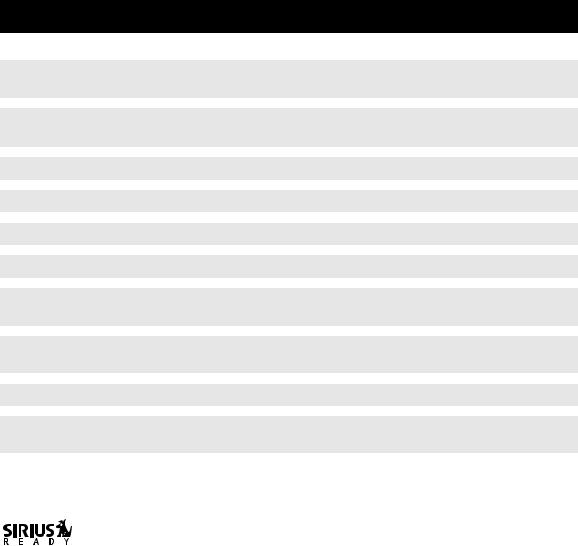
USEFUL FEATURES
This unit allows you to:
Improve sound quality by using the CD Direct Amp*1 and Pure Direct functions
Play back music from your iPhone/iPod*2 or Bluetooth component*2
Play back video content from your iPhone/iPod*1 *2
Listen to SIRIUS Satellite Radio channels*3
Listen to FM and AM radio stations
Boost bass sounds by connecting a subwoofer
Connect an external device*1 such as a graphic equalizer or a surround-sound processor
Use this unit’s remote control to operate other components such as a CD player, BD/DVD player or TV
Save power by using the automatic power down function
Use this unit to listen to another input source in two different rooms
*1 R-S700 only
*2 Optional Yamaha product required
*3 Optional SiriusConnect tuner required
p. 17
p. 35
p. 36
p. 26
p. 20
p. 12
p. 15
p. 47
p. 43
p. 45
SIRIUS, XM and all related marks and logos are trademarks of Sirius XM Radio Inc. and its subsidiaries. All rights reserved. Service not available in Alaska and Hawaii.
iPhone, iPod
iPhone, iPod, iPod classic, iPod nano and iPod touch are trademarks of Apple Inc., registered in the U.S. and other countries.
Bluetooth™
Bluetooth is a registered trademark of the Bluetooth SIG and is used by Yamaha in accordance with a license agreement.
•y indicates a tip for your operation.
•This manual is the owner’s manual for both the R-S700 and the R-S500. Model names are given where the details of functions are unique to each model. Generally, illustrations of the R-S700 are used for explanations.
•Some operations can be performed by using either the buttons on the front panel of this unit or those on the remote controls. In case the button names differ between this unit and the remote controls, the names of the buttons on the remote controls are given in parentheses.
•In case the buttons on the remote control and the Zone 2 remote control have certain functions in common, the illustrations of the buttons on the remote control are used for explanation throughout the manual.
•This manual is printed prior to production. Design and specifications are subject to change in part as a result of improvements, etc. In case of differences between the manual and the product, the product has priority.
2 En
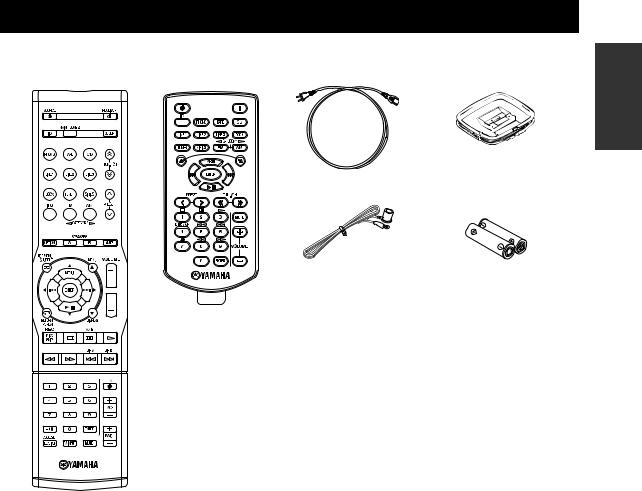
SUPPLIED ACCESSORIES
Please check that you received all of the following parts.
Remote control |
Zone 2 remote control |
Power cable |
AM loop antenna |
|
(R-S700 only) |
(R-S700 only) |
|||
|
|
Indoor FM antenna |
Batteries (x2) |
|
(AAA, R03, UM-4) |
||
|
INTRODUCTION
■Notes on remote controls and batteries
•Do not spill water or other liquids on the remote control.
•Do not drop the remote control.
•Do not leave or store the remote control in the following conditions:
–places of high humidity, such as near a bath
–places of high temperatures, such as near a heater or stove
–places of extremely low temperatures
–dusty places
•Use AAA, R03, UM-4 batteries for the remote control.
•Use a CR2025 battery for the Zone 2 remote control (R-S700 only).
•Insert batteries according to the polarity markings (+ and -).
•Change all batteries if you notice the operation range of the remote control narrows.
•If the batteries run out, immediately remove them from the remote control to prevent an explosion or acid leak.
•If you find leaking batteries, discard the batteries immediately, taking care not to touch the leaked material. If the leaked material comes into contact with your skin or gets into your eyes or mouth, rinse it away immediately and consult a doctor. Clean the battery compartment thoroughly before installing new batteries.
•Do not use old batteries together with new ones. This may shorten the life of the new batteries or cause old batteries to leak.
•Do not use different types of batteries (such as alkaline and manganese batteries) together. Batteries that look the same may have a different specification.
•Before inserting new batteries, wipe the battery compartment clean.
•Dispose of batteries according to your regional regulations.
3 En
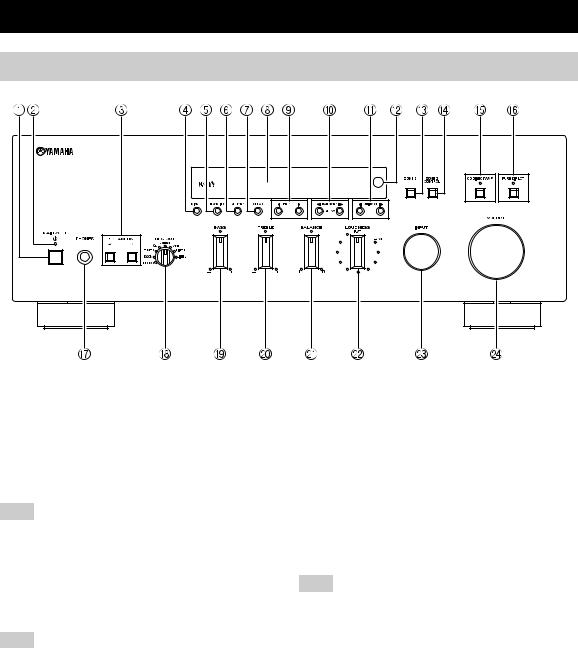
CONTROLS AND FUNCTIONS
Front panel
(R-S700) |
y
 indicates buttons and controls that can also be used to control Zone 2. For more information about Zone 2, see pages 45 and 46.
indicates buttons and controls that can also be used to control Zone 2. For more information about Zone 2, see pages 45 and 46.
1 MAIN ZONE A
Turns on this unit’s Main Zone unit or sets the Main Zone to standby mode (see page 16).
Note
In standby mode, this unit consumes a small amount of power to receive infrared signals from the remote control.
2 MAIN ZONE indicator
Lights up as follows: Brightly lit: Power is on Dimly lit: Standby mode
Note
The MAIN ZONE indicator is brightly lit while an iPhone/iPod is charging.
3 SPEAKERS A/B
Turns on or off the speaker set connected to the SPEAKERS A and/or SPEAKERS B terminals on the rear panel each time the corresponding button is pressed (see page 16).
4 DIMMER
Changes the brightness level of the front panel display. Choose brightness from 3 levels by pressing this button repeatedly.
y
This setting is retained even if you turn off this unit.
5 FM MODE/INFO
Changes the FM radio wave reception mode (stereo or monaural) when TUNER is selected as the input source (see page 21).
Changes the SIRIUS Satellite Radio information displayed on the front panel display when SIRIUS is selected as the input source (see page 34).
Changes the playback information displayed about the song playing on the iPhone/iPod when DOCK is selected as the input source (see page 36).
Note
Playback information can only be displayed for an iPhone/iPod that is connected using a Universal Dock for iPod.
6 MEMORY
Stores the current FM/AM station as a preset when TUNER is selected as the input source (see page 23). Stores the current SIRIUS channel as a preset when SIRIUS is selected as the input source (see page 30).
7 CLEAR
Clears the current FM/AM preset station when TUNER is selected as the input source (see page 24).
Clears the current SIRIUS preset channel when SIRIUS is selected as the input source (see page 32).
8 Front panel display
Shows information about the operational status of this unit.
4 En

9 PRESET j / i
Selects a preset FM/AM station when TUNER is selected as the input source (see page 24).
Selects a preset SIRIUS channel when SIRIUS is selected as the input source (see page 31).
0 FM/CATEGORY l, AM/CATEGORY h 
Sets the FM/AM tuner band to FM or AM when TUNER is selected as the input source (see page 20).
Selects a channel category when SIRIUS is selected as the input source (see page 29).
A TUNING/CH jj / ii 
Selects the tuning frequency when TUNER is selected as the input source (see page 20).
Searches for a SIRIUS channel when SIRIUS is selected as the input source (see page 29).
B Remote control sensor
Receives infrared signals from the remote control.
Note
Switch the remote control ID between ID1 and ID2 when using multiple Yamaha receivers or amplifiers (see page 44).
C ZONE 2
Turns on Zone 2 or sets ZONE 2 to standby mode. When Zone 2 is turned on, signals are output to the ZONE 2 OUT jacks (see page 45).
D ZONE 2 CONTROL
Allows buttons and controls on the front panel to be used to control Zone 2. For more information about controlling Zone 2, see page 46.
E CD DIRECT AMP and indicator (R-S700 only)
Allows you to listen to a CD source in the purest possible sound (see page 17). The indicator lights up and the front panel display turns off when this function is turned on.
Notes
•If both the CD DIRECT AMP and the PURE DIRECT are turned on, only the CD DIRECT AMP will function.
•Zone 2 cannot be used while this function is turned on.
F PURE DIRECT and indicator
Allows you to listen to a source in the purest possible sound (see page 17). The indicator above it lights up and the front panel display turns off when this function is turned on.
Note
Zone 2 cannot be used while this function is turned on.
G PHONES jack
Outputs audio to your headphones for private listening.
Note
Press SPEAKER A/B so that the SP A/B indicators turn off before you connect your headphones to the PHONES jack.
CONTROLS AND FUNCTIONS
H REC OUT selector
Selects a source for recording to a CD recorder or to a tape deck independently of the INPUT selector setting, allowing you to record the selected source while listening to another source (see page 19).
I BASS control
Increases or decreases the low frequency response. The center position produces a flat response (see page 18).
J TREBLE control
Increases or decreases the high frequency response. The center position produces a flat response (see page 18).
K BALANCE control
Adjusts the sound output balance of the left and right speakers to compensate for sound imbalances caused by speaker locations or listening room conditions (see page 18).
L LOUDNESS control
Retains a full tonal range at any volume level to compensate for the human ears’ loss of sensitivity to high and low-frequency ranges at a low volume level (see page 18).
M INPUT selector 
Selects the input source you want to listen to.
N VOLUME control (  R-S700 only)
R-S700 only)
Increases or decreases the sound output level.
Note
This does not affect the output level of the REC jacks.
INTRODUCTION
5 En
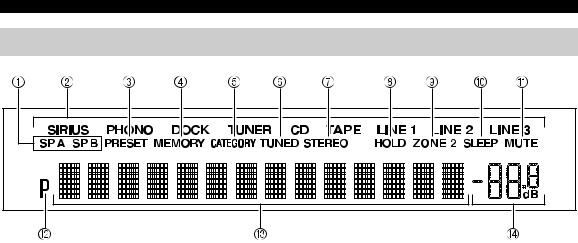
CONTROLS AND FUNCTIONS
Front panel display
1 SP (SPEAKERS) A/B indicators
Light up according to the set of speakers selected. Both indicators light up when both sets of speakers are selected.
2 Input source indicators
Light up brightly to indicate the input source that is currently selected.
B P indicator
Lights up when a preset number is selected. Blinks while you are registering a preset radio station or SIRIUS channel.
C Multi-information display
Shows information when adjusting or changing settings.
D Volume indicator
3 |
PRESET indicator |
Displays the current volume level. |
Lights up when you recall a preset radio station or SIRIUS |
|
|
channel. Blinks while the automatic station preset feature |
|
|
is scanning for FM stations to register as presets. |
|
|
4 |
MEMORY indicator |
|
Lights up or blinks when an FM/AM station or SIRIUS |
|
|
channel is being stored as a preset. |
|
|
5 |
CATEGORY indicator |
|
Lights up when searching for a SIRIUS channel by |
|
|
category. |
|
|
6 |
TUNED indicator |
|
Lights up when this unit is tuned in to an FM or AM |
|
|
station. |
|
|
7 |
STEREO indicator |
|
Lights up when this unit is receiving a strong signal for an |
|
|
FM stereo broadcast. |
|
|
8 |
HOLD indicator |
|
Blinks when the hold function is used to display the artist |
|
|
name, song title, etc. while listening to a SIRIUS channel. |
|
|
9 |
ZONE 2 indicator |
|
Lights up when Zone 2 is turned on. |
|
|
0 |
SLEEP indicator |
|
Lights up when the sleep timer is turned on. |
|
|
A MUTE indicator
Blinks while the MUTE function is turned on.
6 En

CONTROLS AND FUNCTIONS
Rear panel
(R-S700)
INTRODUCTION
1 TRIGGER OUT jack (R-S700 only)
When this unit is turned on or when a certain input source is selected, this unit can send a 12 V/100 mA direct electric current via the TRIGGER OUT jack that can be used to control an external component. The current is sent according to the “Trigger out” setting in the Option menu (see page 40).
Note
Do not connect a component that requires more than 100 mA of electric current, otherwise the component may not perform consistently or properly due to insufficient power.
2 REMOTE 2 IN jack (R-S700 only)
Used to receive remote control signals (see page 45).
3 REMOTE 1 IN/OUT jacks
Used to send and receive remote control signals (see page 45).
4 GND terminal
Used to connect a turntable (see page 12).
5 ZONE 2 OUT jacks
Used to connect a Zone 2 component (see page 45).
6 Antenna terminals
Used to connect FM and AM antennas (see page 14).
7 TAPE jacks
Used to connect a tape deck (see page 12).
8 DOCK jack
Used to connect an optional Yamaha Universal Dock for iPod (such as the YDS-12), Wireless System for iPod (YID-W10), or Bluetooth Wireless Audio Receiver (YBA-10) (see page 35).
9 PHONO jacks
Used to connect a turntable (see page 12).
0 CD jacks
Used to connect a CD player (see page 12).
A LINE 1-3 jacks
Used to connect audio components (see page 12).
B iPod VIDEO output jack (R-S700 only)
Used to send iPhone/iPod video content to a video monitor, such as a TV (see page 35).
Note
Video content output is possible only when an iPhone/iPod is connected this unit using a Universal Dock for iPod (such as the YDS-12).
C SIRIUS jack
Used to connect SiriusConnect tuner (sold separately) (see page 27).
D COUPLER jacks (R-S700 only)
Used to connect an external unit (see page 15).
E SUBWOOFER OUT jack
Used to connect a subwoofer with built-in amplifier (see page 12).
F POWER MANAGEMENT switch
Used to enable or disable the automatic power down function. When this function is enabled, this unit’s Main zone and Zone 2 automatically enters standby mode if this unit is not operated for a certain amount of time (3 settings are available; see page 43).
G SPEAKERS terminals
Used to connect speakers (see page 12).
H IMPEDANCE SELECTOR switch
Used to select the impedance setting (see page 13).
I AC IN (R-S700 only)
Used to plug in the supplied power cable (see page 15).
7 En
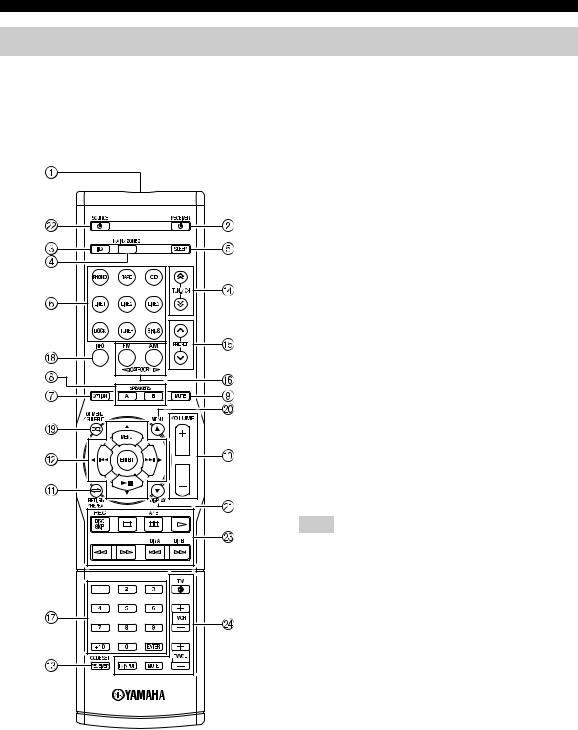
CONTROLS AND FUNCTIONS
Remote control
This section describes the function of each button on the remote control used to control this unit or other components made by Yamaha or other manufacturers.
y
 indicates buttons that can also be used to control Zone 2. For more information about Zone 2, see pages 45 and 46.
indicates buttons that can also be used to control Zone 2. For more information about Zone 2, see pages 45 and 46.
■ Common controls
The following buttons can be used no matter which input source is selected.
1 Infrared signal transmitter
Sends infrared signals.
2 RECEIVER A 
Turns this unit on, or sets it to standby mode.
3 ID
Changes the remote control ID (see page 44).
4 MAIN/ZONE 2
Switches the zone to be operated by the remote control between the Main Zone and Zone 2 (see page 46).
5 SLEEP
Sets the sleep timer (see page 19).
6 Input selector buttons 
Selects the input source and changes the control area (see page 47).
7 OPTION
Turns the OPTION menu on and off (see page 40).
8 SPEAKERS A/B
Turns on and off the set of speakers connected to the SPEAKERS A and/or SPEAKERS B terminals on the rear panel of this unit when the corresponding button is pressed.
9 MUTE 
Mutes the sound output. Press again to restore the sound output to the previous volume level.
0 VOLUME +/– (  R-S700 only)
R-S700 only)
Increases or decreases the sound output level.
Note
This does not affect the output level of the REC jacks.
A RETURN
Returns to the previous menu or ends the menu display when using the Option menu (see page 40).
B B / C / D / E / ENTER
Selects and confirms items in the Option menu (see page 40).
C CODE SET/RECEIVER
Used to program the remote control so that it can control your other external components (see page 49).
After using the remote control to control one of your components, this button is used to switch the remote control to receiver mode so that remote control commands will be sent to this unit (see page 48).
8 En

■ SIRIUS and FM/AM controls
The following buttons can be used when SIRIUS or TUNER is selected as the input source.
D TUN./CH H / I 
Selects the tuning frequency when TUNER is selected as the input source (see page 20).
Searches for a SIRIUS channel when SIRIUS is selected as the input source (see page 29).
E PRESET F / G 
Selects a preset FM/AM station when TUNER is selected as the input source (see page 24).
Select a preset SIRIUS channel when SIRIUS is selected as the input source (see page 31).
FFM/CATEGORY l, AM/CATEGORY h 
Sets the FM/AM tuner band to FM or AM when TUNER is selected as the input source (see page 20).
Selects a channel category when SIRIUS is selected as the input source (see page 29).
GNumeric buttons, ENTER 
Specifies the frequency or the preset number of the FM/ AM station when TUNER is selected as the input source (see page 21).
Specifies the channel number or preset number of the SIRIUS channel when SIRIUS is selected as the input source (see page 30).
H INFO
Changes the SIRIUS Satellite Radio information displayed on the front panel display when SIRIUS is selected as the input source (see page 34).
■ iPod controls
The following buttons can be used when DOCK is selected as the input source for listening to an iPhone/ iPod. For more information, see page 35.
AREPEAT 
BMENU/ Ee / b / a / ENTER 
HINFO
ISHUFFLE 
JB 
KC 
CONTROLS AND FUNCTIONS
■ External component controls
The following buttons can be used to control external audio/video components when CD, TAPE, PHONO, LINE1, LINE2, or LINE3 is selected as the input source. For more information, see page 47.
ARETURN
BB / C / D / E / ENTER
G Numeric buttons, ENTER
ITOP MENU
JMENU
KDISPLAY
LSOURCE A
MExternal component control buttons
NTV control buttons
INTRODUCTION
9 En
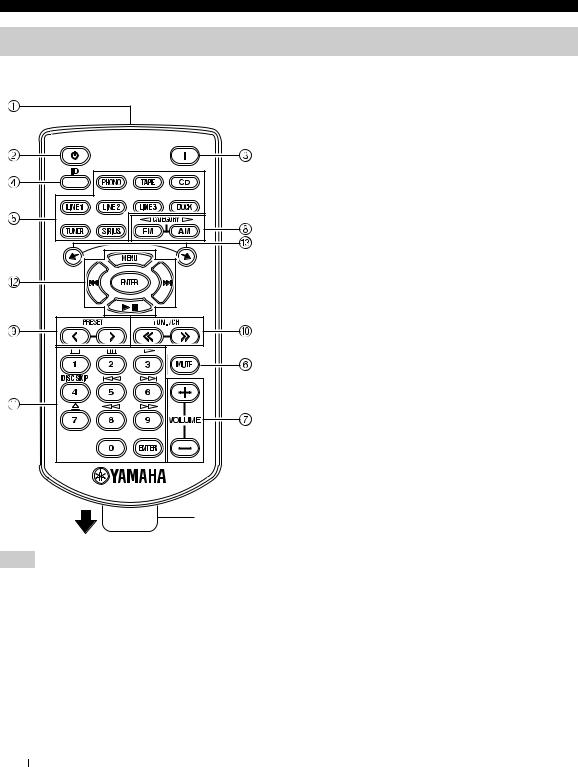
CONTROLS AND FUNCTIONS
Zone 2 remote control (R-S700 only)
This section describes the function of each button on the Zone 2 remote control, which is used to control Zone 2.
Insulation sheet
Note
The Zone 2 remote control comes with a battery already installed. Before using the Zone 2 remote control for the very first time, pull out the insulation sheet, as shown.
■ Common controls for Zone 2
The following buttons can be used no matter which input source is selected for Zone 2.
1Infrared signal transmitter
Sends infrared signals.
2A (Zone 2 standby)
Sets Zone 2 to standby mode.
3(Zone 2 on)
Turns on Zone 2.
4ID
Changes the Zone 2 remote control ID (see page 44).
5 Zone 2 input selector buttons
Selects the desired input source for Zone 2.
6 MUTE
Mutes the sound output to Zone 2. Press again to restore the sound output to the previous volume level.
7 VOLUME +/–
Increases or decreases the sound output level of Zone 2.
■ SIRIUS and FM/AM controls
The following buttons can be used when SIRIUS or TUNER is selected as the input source for Zone 2.
8 FM/CATEGORY l, AM/CATEGORY h
Sets the FM/AM tuner band to FM or AM when TUNER is selected as the input source (see page 20).
Selects a channel category when SIRIUS is selected as the input source (see page 29).
9 PRESET j / i
Selects a preset FM/AM station when TUNER is selected as the input source (see page 24).
Selects a preset SIRIUS channel when SIRIUS is selected as the input source (see page 31).
0 TUN./CH jj / ii
Selects the tuning frequency when TUNER is selected as the input source (see page 20).
Searches for a SIRIUS channel when SIRIUS is selected as the input source (see page 29).
A Numeric buttons, ENTER
Specifies the frequency or the preset number of the FM/ AM station when TUNER is selected as the input source (see page 21).
Specifies the channel number or preset number of the SIRIUS channel when SIRIUS is selected as the input source (see page 30).
■ iPod controls
The following buttons can be used when DOCK is selected as the input source for Zone 2, for listening to an iPhone/iPod. For more information, see page 35.
BMENU/ Ee / b / a / ENTER
C /
/ 
10 En
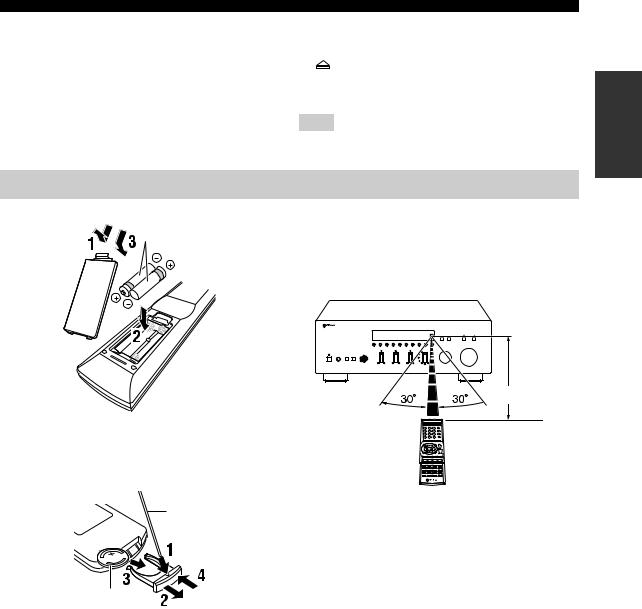
■ Yamaha CD player controls
The following buttons can be used to control a Yamaha CD player when CD is selected as the input source for Zone 2.
A Yamaha CD player control buttons
• |
s |
Stops playback |
• |
e |
Pauses playback |
• |
p |
Starts playback |
• |
DISC SKIP |
Skips to the next disc in a CD changer |
|
|
CONTROLS AND FUNCTIONS |
• |
b |
Skips backward |
• |
a |
Skips forward |
• |
|
Ejects the disc |
• |
w |
Rewinds playback |
• |
f |
Fast-forwards playback |
Note
Not all Yamaha CD players can be controlled by the Zone 2 remote control.
Using the remote controls
■ Installing batteries
AAA, R03, UM-4 batteries
■ Replacing the battery in the Zone 2 remote control
Change the battery when the operation range of the Zone 2 remote control decreases.
Straight pin
CR2025 battery
■ Operation range
The remote controls transmit a directional infrared beam. Be sure to aim the remote controls directly at the remote control sensor on the front panel of this unit or on the infrared signal receiver in Zone 2 during operation.
Approximately
 6 m (20 ft)
6 m (20 ft)
Remote control or Zone 2 remote control
INTRODUCTION
11 En

CONNECTIONS
Connecting speakers and source components
CAUTION
•Do not connect this unit or other components to the main power until all connections between components are complete.
•All connections must be correct: L (left) to L, R (right) to R, “+” to “+” and “–” to “–”. If the connections are faulty, no sound will be heard from the speakers, and if the polarity of the speaker connections is incorrect, the sound will be unnatural and lack bass. Refer to the owner’s manual for each of your components.
•Use RCA cables for audio components (except for speaker connections and DOCK jack connections).
•The IMPEDANCE SELECTOR must be set to the appropriate position before connecting speakers. See page 13 for details.
•Do not let bare speaker wires touch each other or any metal part of this unit. This could damage this unit and/or the speakers.
Turntable
|
|
|
Tape deck |
Audio |
|
Audio |
Audio |
out |
GND |
out |
in |
For information about |
Speakers A |
other components that |
|
can be connected to |
|
this unit, see page 35. |
|
Audio |
Audio |
Audio |
Audio |
Audio |
|
out |
out |
out |
in |
out |
|
CD player |
VCR, etc. |
DVD player, |
CD recorder, |
Subwoofer |
Speakers B |
|
|
etc. |
etc. |
|
|
y
•The PHONO jacks are designed for connecting a turntable with an MM cartridge.
•Connect your turntable to the GND terminal to reduce noise in the signal. However, for some turntables, you may hear less noise without the GND connection.
12 En
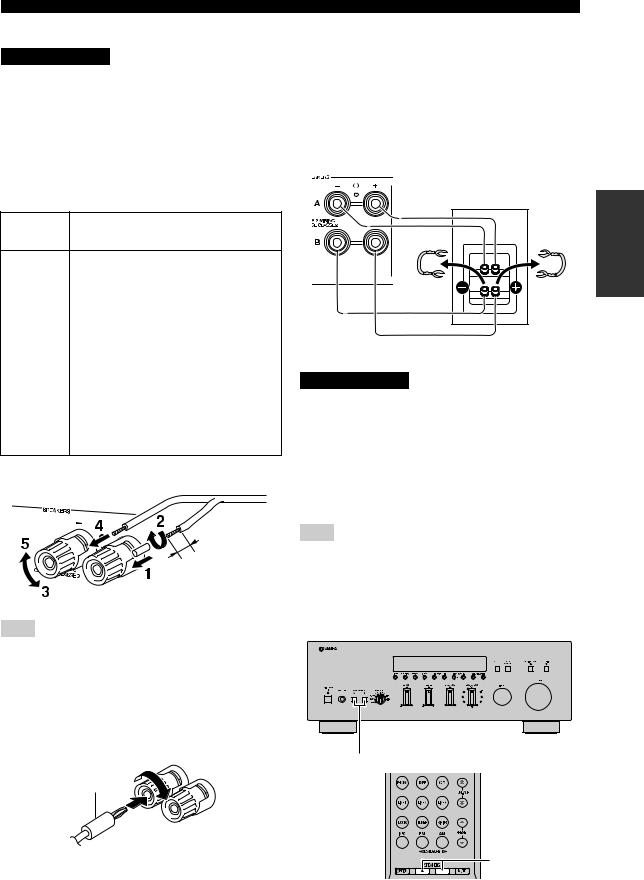
■ IMPEDANCE SELECTOR switch
CAUTION
Do not change the IMPEDANCE SELECTOR switch while the power of this unit is turned on, as doing so may damage the unit.
If the unit fails to turn on, the IMPEDANCE SELECTOR switch may not be fully slid to either position. If this is the case, remove the power cable and slide the switch all the way to either position.
Select the switch position (LOW or HIGH) according to the impedance of the speakers in your system.
Switch
Impedance level
position
•If you use one set (A or B), the impedance of each speaker must be 6 Ω or higher (R-S700)
or 8 Ω or higher (R-S500).
HIGH • If you make bi-wire connections, the impedance of each speaker must be 6 Ω or higher (R-S700) or 8 Ω or higher (R-S500). See page 13 for Bi-wire connection.
|
• If you use one set (A or B), the impedance of |
|
|
each speaker must be 4 Ω or higher. |
|
|
• If you use two sets (A and B) simultaneously, |
|
LOW |
the impedance of each speaker must be 8 |
Ω or |
higher. |
|
|
|
|
|
•If you make bi-wire connections, the impedance of each speaker must be 4 Ω or higher. See page 13 for Bi-wire connection.
■Connecting speaker cables
Remove approximately 10 mm (3/8 in) of insulation from the end of each speaker cable.
Note
When inserting speaker cables into the speaker terminals, insert only the bare speaker wire. If insulated cable is inserted, the connection may be poor and sound may not be heard.
■ Connecting via banana plug
Tighten the knob and then insert the banana plug into the end of the corresponding terminal.
CONNECTIONS
■ Bi-wire connection
Bi-wire connection separates the woofer from the combined midrange and tweeter section. A bi-wire compatible speaker has four binding post terminals. These two sets of terminals allow the speaker to be split into two independent sections. With these connections, the mid and high frequency drivers are connected to one set of terminals and the low frequency driver to another set of terminals.
This unit
Speaker
PREPARATION
Connect the other speaker to the other set of terminals in the same way.
CAUTION
When making bi-wire connections, set the IMPEDANCE SELECTOR switch to HIGH or LOW depending on the impedance of your speakers:
6 Ω or higher: HIGH (R-S700)
8 Ω or higher: HIGH (R-S500)
4 Ω or higher: LOW
See page 13 for more information about the IMPEDANCE SELECTOR switch.
Note
When making bi-wire connections, remove the shorting bridges or cables on the speaker.
y
To use the bi-wire connections, press SPEAKERS A and SPEAKERS B on the front panel or on the remote control so that both SP A and B light up on the front panel display.
SPEAKERS A/B
Banana plug 
SPEAKERS A/B
13 En
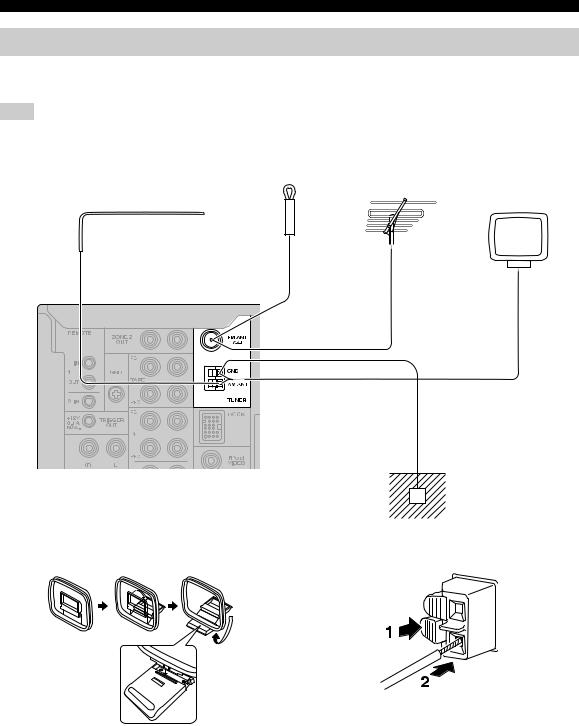
CONNECTIONS
Connecting the FM and AM antennas
Indoor antennas for receiving FM and AM broadcasts are included with this unit. In general, these antennas should provide sufficient signal strength. Connect each antenna correctly to the designated terminals.
Note
If you experience poor reception quality, install an outdoor antenna. Consult the nearest authorized Yamaha dealer or service center about outdoor antennas.
Outdoor AM antenna
Use 5 to 10 m of vinylcovered wire extended outdoors from a window.
Indoor FM antenna (included)
Outdoor FM antenna
AM loop antenna (included)
• The AM loop antenna should always be connected, even if an outdoor AM antenna is connected to this unit.
• The AM loop antenna should be placed away from this unit.
Ground (GND terminal)
For maximum safety and minimum interference, connect the antenna GND terminal to a good earth ground. A good earth ground is a metal stake driven into moist earth.
■Assembling the supplied AM loop antenna
■Connecting the wire of the AM loop antenna
14 En
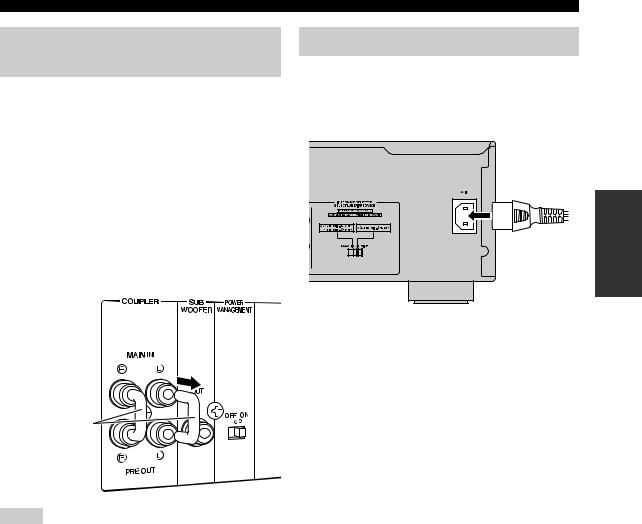
Using COUPLER jacks (R-S700 only)
Removing the jumper pins from the PRE OUT/MAIN IN jacks enables this unit to operate separately as a control amplifier or a power amplifier. These jacks are used to connect a signal-processing system such as a graphic equalizer or a surround-sound processor to this unit. If an external unit is connected to these jacks, the VOLUME control of this unit can be used to adjust the overall sound output level.
To connect an external unit, first remove the jumper pins from the PRE OUT/MAIN IN jacks and then connect the input jacks of that external unit to the PRE OUT jacks or its output jacks to the MAIN IN jacks. For details, refer to the owner’s manual included with the external unit to be connected.
Jumper pins
CONNECTIONS
Connecting power cable
Plug the power cable into the AC IN on the rear panel of this unit (R-S700 only).
Plug the power cable into the AC wall outlet after all other connections are complete.
Power cable (R-S700 only)
PREPARATION
Notes
•If you do not use the COUPLER jacks, never remove the jumper pins from these jacks. If removed, no sound will be output from this unit.
•Before installing or removing the jumper pins, be sure to disconnect the power cable of the unit. Leaving the power cable connected could cause noise to be emitted from the speakers or damage the unit.
•When you use this unit as a power amplifier, connect the output jacks of the external control amplifier, etc. to the MAIN IN jacks of this unit. In this case, the controls of this unit will not function except the PHONES jack and the SPEAKERS A/B buttons. Use the controls on the external control amplifier to make volume adjustments, etc.
15 En

PLAYING AND RECORDING
CAUTION
Extreme caution should be exercised when you play back CDs encoded in DTS.
If you play back a CD encoded in DTS on a CD player that does not support DTS, only noise will be heard, and this noise may damage your speakers. Check whether your CD player supports CDs encoded in DTS. Also, check the sound output level of your CD player before you play back a CD encoded in DTS.
Playing a source
|
|
|
|
|
|
|
|
|
|
|
|
|
|
|
|
|
|
|
|
|
|
|
|
|
|
|
|
|
|
|
|
|
|
|
|
|
|
|
|
|
|
|
|
|
|
|
|
|
|
|
|
|
SPEAKERS A/B |
INPUT selector |
|
|||||||||
MAIN ZONE A |
|
|
VOLUME |
|||||||||
3Press SPEAKERS A and/or SPEAKERS B on the front panel or on the remote control to select speakers A and/or speakers B.
When speaker set A or speaker set B are turned on, SP A or SP B is displayed on the front panel display accordingly (see page 6).
Notes
•When one set of speakers is connected using bi-wire connections, or when using two sets of speakers simultaneously (A and B), make sure SP A and SP B are displayed on the front panel display.
•When listening with headphones, turn off the speakers.
RECEIVER A
Input selector buttons
SPEAKERS A/B
VOLUME +/–
1Press MAIN ZONE A on the front panel (or RECEIVER A on the remote control) to turn on this unit.
2Rotate the INPUT selector on the front panel (or press one of the input selector buttons on the remote control) to select the input source you want to listen to.
4Play the source.
5Rotate the VOLUME control on the front panel (or press VOLUME +/– on the remote control) to adjust the sound output level.
y
You can adjust the tonal quality by using the BASS, TREBLE, BALANCE and LOUDNESS controls, the CD DIRECT AMP switch (R-S700 only), or the PURE DIRECT switch on the front panel (see page 17).
6Press MAIN ZONE A on the front panel again (or RECEIVER A on the remote control) to finish using this unit and set it to standby mode.
16 En
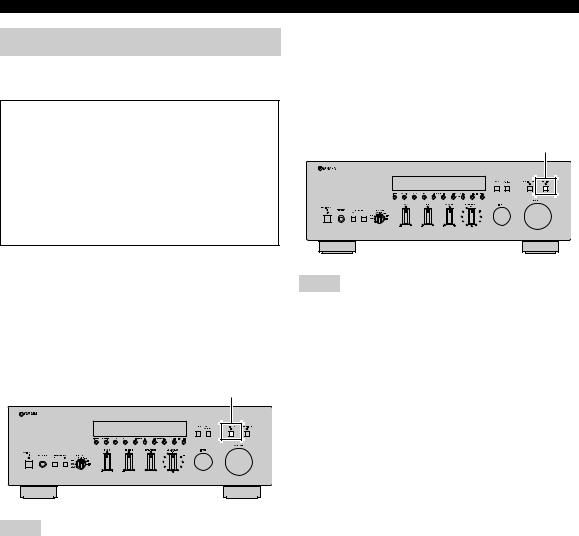
Adjusting the tonal quality
■Using the CD DIRECT AMP switch (R-S700 only)
CD Direct Amp feature
Generates a normal phase and reverse phase signal for both the left and right channels from the input signal and uses the four electronic volumes to send a balanced signal to the amplifying circuit. This feature provides clearer sound as a result of:
•improved signal-to-noise ratio
•external noise canceling
•reduced distortion
Routes input signals from your CD player directly to the specially built-in amplifier for the CD player. As a result, the input signals bypass the INPUT selector and the BASS, TREBLE, BALANCE and LOUDNESS controls and then sent to the power amplifier, thus eliminating any alterations to the CD signals and creating the purest possible sound. The CD DIRECT AMP indicator lights up and the front panel display turns off after a few seconds.
CD DIRECT AMP switch
Notes
•If both the CD DIRECT AMP and the PURE DIRECT switches are turned on, only the CD DIRECT AMP switch will function.
•Zone 2 cannot be used while the CD DIRECT AMP feature is turned on.
•The INPUT selector and the BASS, TREBLE, BALANCE, and LOUDNESS controls do not function while the CD DIRECT AMP feature is turned on.
•A CD player must be connected to the CD jacks in order to use the CD DIRECT AMP feature.
•This setting is retained even if you turn off this unit.
PLAYING AND RECORDING
■ Using the PURE DIRECT switch
Routes input signals from your audio sources so that the input signals bypass the BASS, TREBLE, BALANCE and LOUDNESS controls, thus eliminating any alterations to the audio signals and creating the purest possible sound. The PURE DIRECT indicator lights up and the front panel display turns off after a few seconds.
PURE DIRECT switch
Notes
•Zone 2 cannot be used while the PURE DIRECT feature is turned on.
•The BASS, TREBLE, BALANCE, and LOUDNESS controls do not function while the PURE DIRECT feature is turned on.
•This setting is retained even if you turn off this unit.
OPERATION |
BASIC |
|
|
17 En
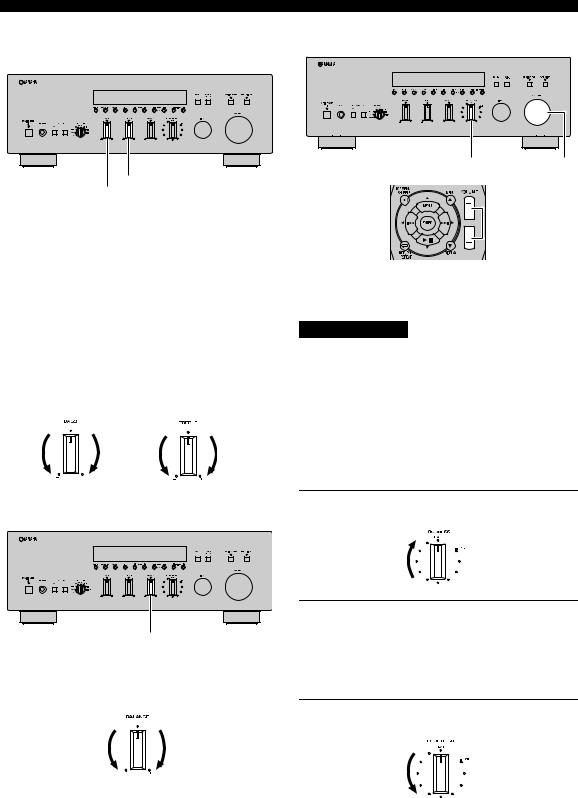
PLAYING AND RECORDING
■Adjusting the BASS and TREBLE controls
TREBLE
BASS
The BASS and TREBLE controls adjust high and low frequency response.
The center position produces a flat response.
BASS
When you feel there is not enough bass (low frequency sound), rotate clockwise to boost. When you feel there is too much bass, rotate counterclockwise to suppress. Control range: –10 dB to +10 dB (20 Hz)
TREBLE
When you feel there is not enough treble (high frequency sound), rotate clockwise to boost. When you feel there is too much treble, rotate counterclockwise to suppress.
Control range: –10 dB to +10 dB (20 kHz)
■ Adjusting the BALANCE control
BALANCE
The BALANCE control adjusts the sound output balance of the left and right speakers to compensate for sound imbalance caused by speaker locations or listening room conditions.
■ Adjusting the LOUDNESS control
LOUDNESS VOLUME
 VOLUME +/–
VOLUME +/–
Retain a full tonal range at any volume level, thus compensating for the human ears’ loss of sensitivity to high and low-frequency ranges at low volume.
CAUTION
If the CD DIRECT AMP switch (R-S700 only) or the PURE DIRECT switch is turned on with the LOUDNESS control set at a certain level, the input signals bypass the LOUDNESS control, resulting in a sudden increase in the sound output level. To prevent your ears or the speakers from being damaged, be sure to press the CD DIRECT AMP switch (R-S700 only) or the PURE DIRECT switch after lowering the sound output level or after checking that the LOUDNESS control is properly set.
1Set the LOUDNESS control to the FLAT position.
2Rotate the VOLUME control on the front panel (or press VOLUME +/– on the remote control) to set the sound output level to the loudest listening level that you would listen to.
3Rotate the LOUDNESS control until the desired volume is obtained.
y
After setting the LOUDNESS control, enjoy listening to music at your preferred volume level. If the effect of the LOUDNESS control setting is too strong or weak, readjust the LOUDNESS control.
18 En
